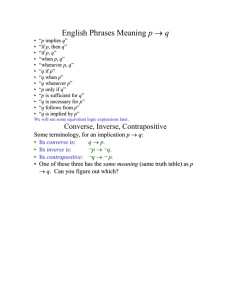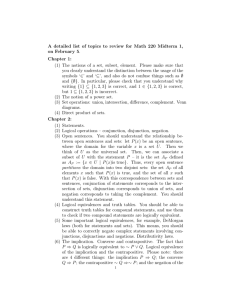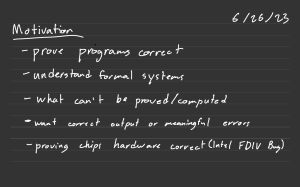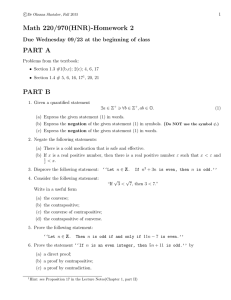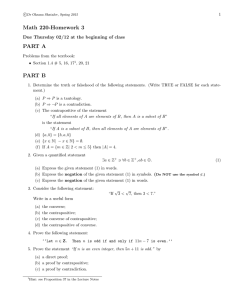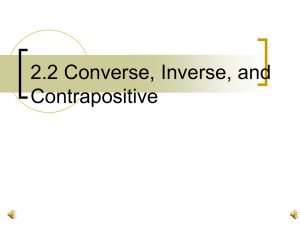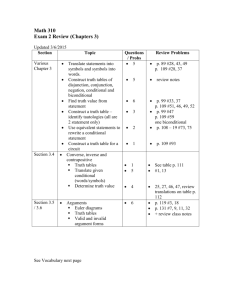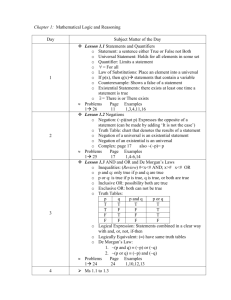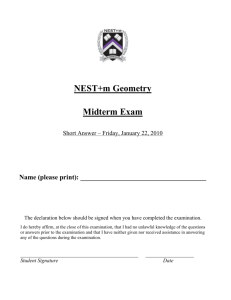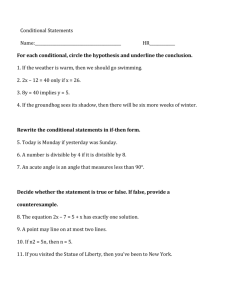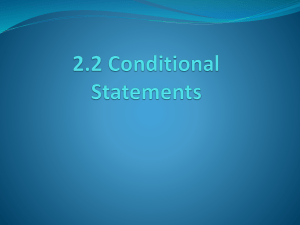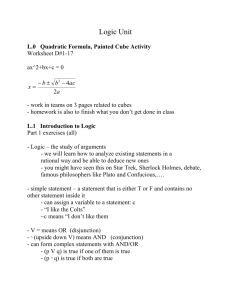Document 10389948
advertisement
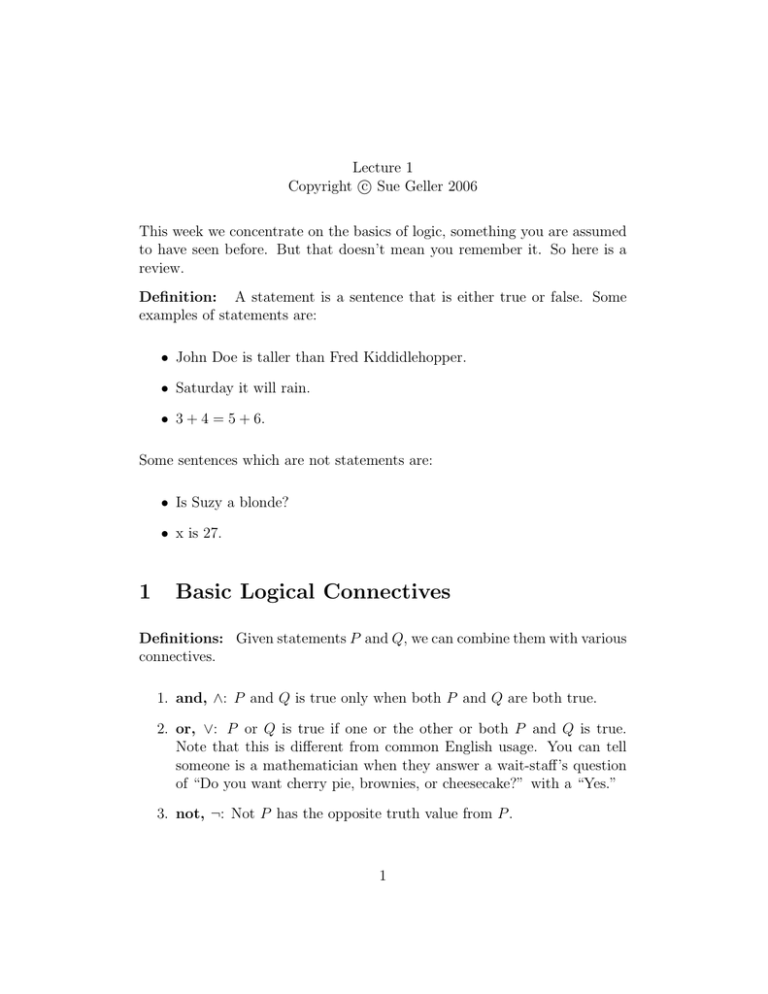
Lecture 1 c Sue Geller 2006 Copyright This week we concentrate on the basics of logic, something you are assumed to have seen before. But that doesn’t mean you remember it. So here is a review. Definition: A statement is a sentence that is either true or false. Some examples of statements are: • John Doe is taller than Fred Kiddidlehopper. • Saturday it will rain. • 3 + 4 = 5 + 6. Some sentences which are not statements are: • Is Suzy a blonde? • x is 27. 1 Basic Logical Connectives Definitions: Given statements P and Q, we can combine them with various connectives. 1. and, ∧: P and Q is true only when both P and Q are both true. 2. or, ∨: P or Q is true if one or the other or both P and Q is true. Note that this is different from common English usage. You can tell someone is a mathematician when they answer a wait-staff’s question of “Do you want cherry pie, brownies, or cheesecake?” with a “Yes.” 3. not, ¬: Not P has the opposite truth value from P . 1 4. implies, ⇒: P implies Q or equivalently P ⇒ Q is true unless P is true and Q is false. This one often gives people problems. How can starting with something false produce a true statement? But it does! In fact, starting with something false, you can prove anything using proper logic. This tells us the importance of starting with true assumptions! There is an old story about Bertrand Russell, an eminent mathematician at the turn of the 20th century. It seems he was lecturing the London Philosophical Society on just this point. After he had lectured rather pompously for over an hour, a gentleman in the back rose and said, “Sir, assuming that 2 = 1, prove that you are the Pope.” Without a moment’s thought, Bertrand Russell replied, “I am a man. The Pope is a man. So we are two men. Since two equals one, I am the Pope.” 5. if and only if or biconditional or ⇔: P ⇔ Q is true when P and Q are both true or both false but is false otherwise. Notice the difference between implies and if and only if. We were brought up tending to assume that if meant if and only if, as in the parental “If you clean your room, you may go to the movies.” The parent meant if and only if but stated it as an if, not actually saying that, if you don’t clean your room, you may not go to the movies. An exception to the if doesn’t mean if and only if is in mathematical definitions. I could have defined statement “A sentence is a statement if and only if it can be determined to be true or false.” That would be proper, but mathematicians are lazy and would more frequently write “A sentence is a statement if it can be determined to be true or false.” I will use the convention of if for if and only if in definitions. Another format in which to display the truth or falsehood of a logical statement is a truth table. Starting with columns for the basic statements, P, Q, R, S, ..., one then makes columns to to build up your statement. The following is a truth table for the logical connectives. 2 P T T F F Q ¬P T F F F T T F T P ∧Q P ∨Q P ⇒Q P ⇔Q T T T T F T F F F T T F F F T T In fact, one can show that two logical expressions are equivalent by showing they have the same truth values in all circumstances. For example, it is not necessary to have the connective ⇒ because P ⇒ Q is equivalent to ¬P ∨ Q, as can be seen in the following truth table. P T T F F 2 Q ¬P T F F F T T F T P ⇒ Q ¬P ∨ Q T T F F T T T T Implies and its Relatives An equivalent way of writing P implies Q is “If P , then Q.” the form usually used in English writing, and is called an implication. There are three statements that are gotten from the implication: • Converse: If Q, then P . • Inverse: If ¬P , then ¬Q. • Contrapositive: If ¬Q, then ¬P . We can see that the implication and the contrapositive are equivalent because both are equivalent to ¬P ∨ Q. Similarly, the inverse and the converse are equivalent. But the converse and inverse are not equivalent to the implication and the contrapositive. A simple example is the implication “If there is light coming through the window, then there is light in the room.” The converse is “If there is light in the room, then there is light coming through the window.” a false statement at night or in a room without windows. So be careful with your implications but remember that you can prove the contrapositive and still have proven the implication. 3 3 Quantifiers There are two basic quantifies, for all (∀) and there exists (∃). For all has many forms in English – for each, for any, any, every, for every. There exists may be expressed as some, for some, there is a(n). These are used in sentences with variables in them. For example, • There is an integer that is positive. • Every positive real number has a positive real square root. • For every ǫ > 0, there exists a δ > 0 such that, if |x − a| < δ, then |f (x) − f (a)| < ǫ. In general there exists requires a such that. In symbols we often use symbols for the statements or simply combine words and English. For example, p ∀x ∈ R+ , (x) ∈ R+ or ∀ǫ > 0 ∃δ > 0 such that |x − a| < δ ⇒ |f (x) − f (a)| < ǫ. 4 Negation By using a truth table (try it!) you can see that ¬(P ∧ Q) is equivalent to ¬P ∨ ¬Q and similarly that ¬(P ∨ Q) is equivalent to ¬P ∧ ¬Q. Thus, since P ⇒ Q is equivalent to ¬P ∨ Q, ¬(P ⇒ Q) is equivalent to P ∧ ¬Q. But what about quantifiers? The negation of ∀xP (x) is not For no x, P (x) but ∃x(¬P (x)). Similarly, the negation of ∃x(P (x)) is ∀x¬P (x). For example, the negation of the third example above is ∃ǫ > 0(∀δ > 0, |x − a| < δ ∧ |f (x) − f (a)| ≥ ǫ). 4
